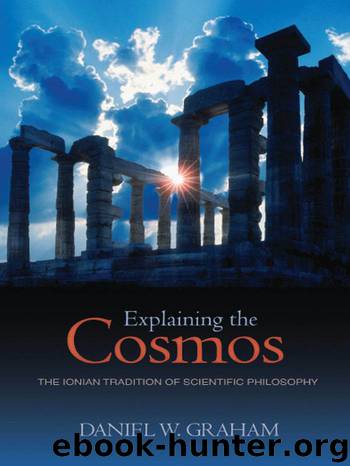Explaining the Cosmos by Graham Daniel W

Author:Graham, Daniel W.
Language: eng
Format: epub
ISBN: 9781400827459
Publisher: Princeton University Press
7
ANAXAGORAS AND EMPEDOCLES ELEATIC PLURALISTS
ANEW STYLE OF scientific theory appears after Parmenides. Anaxagoras, Empedocles, and later the atomists account for natural phenomena by appealing not to some single primeval substance that generates all things, but to some set of permanent substances that interact in such a way that all things arise from them. The set of substances always consists of a plurality; hence the new practitioners of cosmology are known as pluralists. They also continue to pursue the aims and ends of earlier Ionian philosophy. Hence they have been called neoIonians.1 What accounts for the new style of explanation, how does it build on its Ionian roots, and how does it go beyond them?2
7.1 The Standard Interpretation
Our understanding of the relationship between the neoIonians and their predecessors has changed hardly at all since the early twentieth century. There have been squabbles about details of the succession and fine points of interpretation. But the general conception of what the neo-Ionians are up to is virtually the same now as several generations ago. The story is as follows.
The early Ionian philosophers had explained the world by positing a single substance such as water or air, which was transformed into other substances and ordered into a cosmos. They were monists in the sense of proposing a single original substance from which all things come, but in their theories the original substance comes to manifest contrary qualities such as hot and cold. Parmenides sees serious shortcomings in the views of the Ionians.3 Drawing a distinction between being and not-being, he argues that not-being cannot be thought or known. He goes on to rule out the possibility of coming to be and passing away, then all change and differentiation, finally arriving at a strict essential monism (being is the only type of entity) and numerical monism. Change and difference are ruled out, along with any possibility for accepting the evidence of our senses concerning the phenomenal world, and along with any possibility that scientific study could account for it.
The pluralists, realizing that the possibility of scientific explanation, indeed of any explanation of human experience, is at risk, desperately attempt to halt the march of Eleatic logic. Seeing that monism renders change and difference impossible, they posit the existence of a plurality of beings. These beings conform, so far as is possible, to the strict requirements of Eleatic being: they are everlasting, changeless in their nature, complete and self-identical. But there is a plurality of them. And that plurality allows for the possibility of difference, change, and ultimately the existence of the cosmos. Cosmology and scientific study can accordingly be rescued from the Eleatic elenchus.
On this view the pluralists are at once indebted to Parmenides and opposed to him. They accept his general principles that what-is should be permanent and self-identical, that not-being should be ruled out.4 But they oppose his overall conclusions and seek to make room in philosophy for change by attacking Parmenides’ monism and, moreover, his claim that every other kind of change is as incoherent as coming to be and passing away.
Download
This site does not store any files on its server. We only index and link to content provided by other sites. Please contact the content providers to delete copyright contents if any and email us, we'll remove relevant links or contents immediately.
| Aeronautics & Astronautics | Astronomy |
| Astrophysics & Space Science | Comets, Meteors & Asteroids |
| Cosmology | Mars |
| Solar System | Star-Gazing |
| Telescopes | UFOs |
Tools of Titans by Timothy Ferriss(8218)
Turbulence by E. J. Noyes(7936)
Secrets of Antigravity Propulsion: Tesla, UFOs, and Classified Aerospace Technology by Ph.D. Paul A. Laviolette(5309)
Astrophysics for People in a Hurry by Neil DeGrasse Tyson(5130)
Room 212 by Kate Stewart(5035)
Design of Trajectory Optimization Approach for Space Maneuver Vehicle Skip Entry Problems by Runqi Chai & Al Savvaris & Antonios Tsourdos & Senchun Chai(5011)
Pale Blue Dot by Carl Sagan(4912)
The David Icke Guide to the Global Conspiracy (and how to end it) by David Icke(4625)
A Journey Through Divination and Astronomy by Publishing Pottermore(4344)
Goodbye Paradise(3726)
Apollo 8 by Jeffrey Kluger(3637)
COSMOS by Carl Sagan(3554)
Losing the Nobel Prize by Brian Keating(3498)
The Five People You Meet in Heaven by Mitch Albom(3474)
How to Read Water: Clues and Patterns from Puddles to the Sea (Natural Navigation) by Tristan Gooley(3406)
Brief Answers to the Big Questions by Stephen Hawking(3369)
How to Read Nature by Tristan Gooley(3249)
The Order of Time by Carlo Rovelli(3145)
A Brief History of Time by Stephen Hawking(2960)
